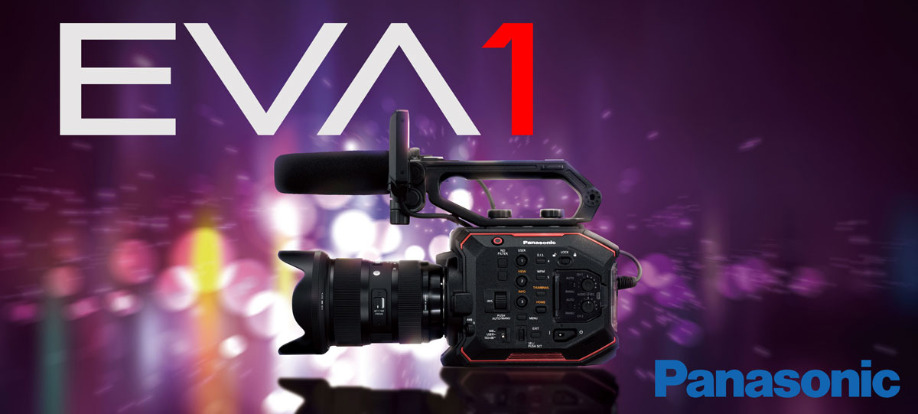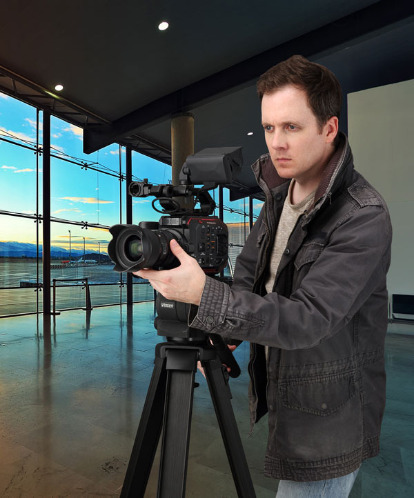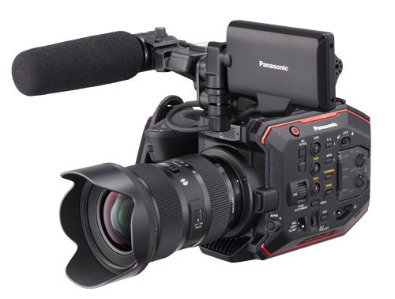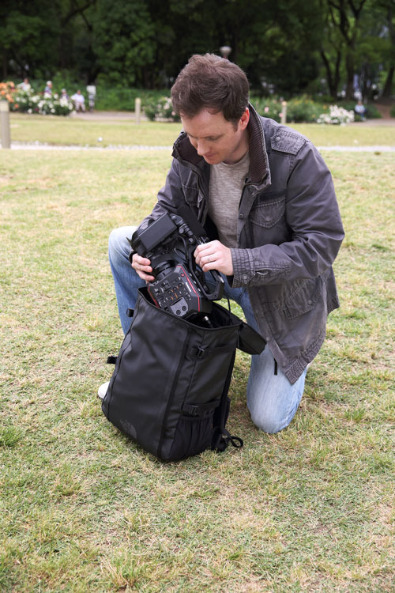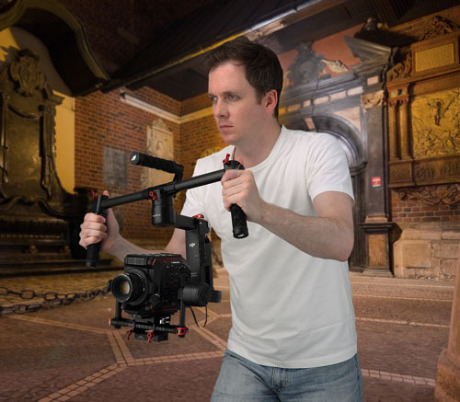Announcing the Panasonic EVA1
The Panasonic EVA1 is eligible for the Varicam
2 Year - 0% Financing


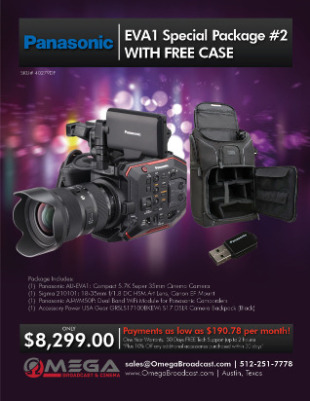
EVA1
QUESTIONS ANSWERED
At Cine Gear Expo 2017 in Hollywood, Panasonic previewed the AU-EVA1 cinema camera. Equipped with a newly designed 5.7K Super-35 sensor and positioned between the Panasonic Lumix GH5 4K mirrorless camera and the VariCam LT 4K cinema camera, the EVA1 generated tremendous buzz since being teased at NAB 2017. Compact and lightweight, the AU-EVA1 is tailor-made for handheld shooting, but also well suited for documentaries, commercials, and music videos.
We asked Panasonic Cinema Product Manager, Mitch Gross, some general questions on the EVA1’s target audience, shooting applications, Dual Native ISO, the 5.7K sensor, and more.
What will be the main shooting applications for EVA1?
MITCH GROSS: I think you’re going to see a lot of people shooting documentary style work with the EVA1 – talking head interviews and B-roll shots in the field. It’s very convenient for that style of shooting. You’re also going to have people who do news shooting, as well as live event type work such as wedding sand sports videography. In addition, there will be people who will want to rig the camera for specific types of remote work,meaning mounting the camera out on a crane, or jib arm. You want it fully featured yet small and lightweight because the bigger your camera is, the bigger crane you would have to use,just like on a Steadicam. Gimbal devices like a [Freefly Systems]MōVI or a [DJI] Ronin want a fully featured camera but in a small and lightweight package. With EVA1, you get the dual advantage of having great capabilities while being lightweight and small.Same goes for underwater housings, car rigs, or anytime you need to place a camera somewhere where you want a slimmed down unit that won’t get in the way. You still want to have a capable camera, especially with a Super35 sensor, and the EVA1provides just that.
For whom is the EVA1 designed?
MITCH GROSS: Depending on the type of work you do, EVA1answers a lot of different needs. It is designed to be a versatile machine that you can plug into a lot of different situations. There are people who have been shooting on smaller cameras such as DSLRs or all-in-one camcorders, and they have felt limitations.At the same time, you have other people who have been shooting on large production cameras and they sometimes have need for a camera that is slimmed down and more portable. What we wanted to do was build a camera that could sit in-between those spaces where you could essentially rise up from the small cameras where you want more versatility and you don’t have to fight the machine sometimes. Or you could slim down from a bigger camera for projects where a larger system may be too difficult to deal with or simply too expensive for the production.On the little cameras, you can get amazing work out of these tiny machines but because they’re so small, dealing with the control scan become a barrier and you often must devise workarounds.Shooters put up with the workarounds because these small cameras are so convenient to shoot with. We’ve risen the scale of the camera so now you have these high-end features and easier access to controls in a camera that is a more functional size for most shooters. For users of higher level production machines,we’ve tried to be judicious in keeping as much professional functionality as possible into a compact form factor.
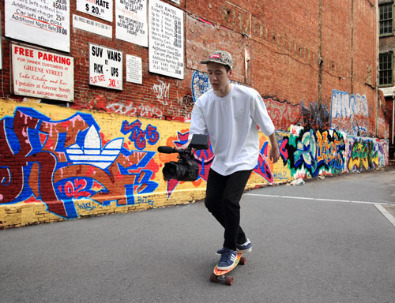
What are some of the specific featuresEVA1 gives you that a compact DSLR or mirrorless camera won’t?
MITCH GROSS: The first thing is that people who are shooting with a [Panasonic Lumix] GH5, is that they are shooting with aMicro Four Thirds sensor and EVA1 contains a Super-35 sensor,which gives you a different look and feel. The larger body size of the camera, the design of the interface, and where the LCD is located all give you better access to the controls to make adjustments while rolling. With small DSLR cameras, you can’t comfortably change things as you’re rolling in a run-and-gun style and that’s a problem – you need to be able to adjust on the fly.In addition, we have proper connectors – real XLR audio inputs,full-size HDMI and locking SDI connectors for video outputs. We have a full-fledged camera that’s designed for video production.It has a removable side hand grip with integrated controls. TheEVA1 is designed to be held up to your shoulder as opposed to way out in front of you, or at your waist. Another example of control you have while shooting video are the integrated ND filters. You have a filter wheel that is built into the camera so you
For a cinematographer that has never shot with a VariCam before, can you explain the Dual Native ISO feature?
MITCH GROSS: Panasonic developed a process to read the sensor’s photo sites in a fundamentally different way than it’s traditionally done. More information can be extracted without degrading the image. That effectively gives the imager greater sensitivity and separates the signal from the background noise.It’s essentially a different way of reading the camera sensor and it gives it two different native ISOs or sensitivities. Whereas in all others cameras, you just dial the gain up to get more sensitivity but you get a lot of noise in the image. You can also do that on the EVA1, but if you just switch between the two native ISOs, they’ll look the same as far as the amount of noise. There are two ways that one might likely want to use this. First, you can shoot with zoom lenses when normally you would have to shoot with primes because zoom lenses generally aren’t as fast. Instead of having to switch prime lenses, you have more versatility while still getting the right exposure. Another way of using Dual Native ISO is the ability to lower your light levels. In shooting with lower light levels, you will save money, time, and you can shoot with more practical lights in your surroundings.That can be for a high-end production or a more modest production where it can be used for savings, or a stylistic choice.
Recent Posts
-
New Canon Cinema EOS Firmware Now Available
Canon Releases Powerful Cinema EOS Firmware Updates December 2025 firmware updates deliver new r …Dec 19th 2025 -
Ross Video Ultrix: A Routing Platform Built for Flexibility, Scale, and Modern Broadcast
Broadcast Technology • Routing • Production Workflows Ross Video Ultrix: A Routing Platform Built …Dec 17th 2025 -
HelixNet HXII-BP-4K: Four-Channel Beltpacks for Modern Intercom Workflows
HelixNet HXII-BP-4K: Four-Channel Beltpacks for Modern Intercom Workflows Clear-Com’s latest Heli …Dec 12th 2025

